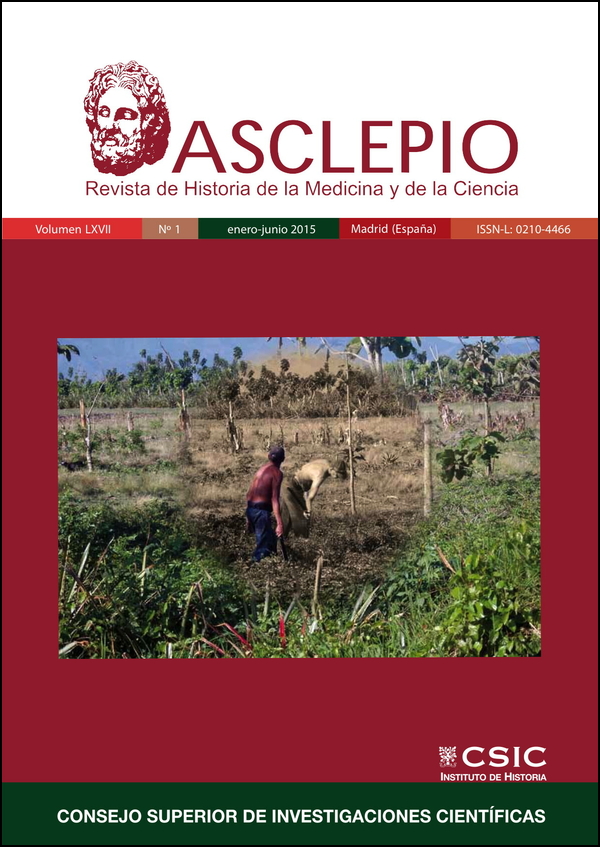El origen africano del cultivo del arroz en Las Américas
DOI:
https://doi.org/10.3989/asclepio.2015.03Palabras clave:
Arroz africano, Diáspora africana, Comercio transatlántico de esclavos, Sistema de conocimiento tradicional, SubsistenciaResumen
El arroz no empezó a ser cultivado en las Américas sino hasta el periodo del comercio transatlántico de esclavos. Para el siglo XVIII este cultivo ya se había establecido extensamente en plantaciones desde Carolina del Sur hasta Brasil. Cultivado por esclavos así como cimarrones, tanto para la subsistencia como para la exportación, el comienzo de la cultivación de arroz en las Américas invariablemente se ha atribuido a los dueños de plantaciones europeos. Este artículo presenta evidencia del importante papel que desempeñaron los africanos en establecer la cultura del arroz en el Nuevo Mundo. Este trabajo se enfoca sobre el arroz africano (Oryza glaberrima), personas esclavizadas de África occidental para quienes este cultivo era un alimento básico, y un sistema de conocimiento indígena sobre el arroz con características idénticas entre el Atlántico africano y americano. Un estudio comparativo de usos del suelo, métodos de cultivo, procesos de molienda y tradiciones culinarias ilumina el tema de la difusión de la cultura africana de arroz a las Américas, así como la labor que desempeñaron los esclavos de África occidental en liderar el cultivo de arroz para eventualmente convertirlo en un alimento básico de subsistencia en el Nuevo Mundo.
Descargas
Citas
Allston, R.F.W. (1846), "Memoir of the Introduction and Planting of Rice in South Carolina", De Bow's Review, 1, pp. 320-357.
Barry, Boubacar (1998), Senegambia and the Atlantic Slave Trade. Cambridge, University Press.
Blake, J.W. (1977), West Africa: Quest for God and Gold, 1545-1578. London, Curzon Press.
Brooks, George (1993), Landlords and Strangers. Ecology, Society and Trade in Western Africa, 1000-1630. Boulder, Westview Press.
Brahm, John Gerard William de (1971), "De Brahm's Report". En: Vorsey, Jr., Louis de (ed.) Report on the General Survey in the Southern District of North America, Columbia, University of South Carolina Press, pp. 61-131.
Carney, Judith (2001), Black Rice. The African Origins of Rice Cultivation in the Americas. Cambridge, Mass, Harvard University Press.
Carreira, A. (1984), Os portuguêses nos rios de Guiné, 1500-1900. Lisbon, privately published.
Clifton, James (1981), "The Rice Industry in Colonial America", Agricultural History, 55, pp. 266-83.
Collinson, P. (1766), "Of the Introduction of Rice and Tar in our Colonies", Gentleman's Magazine, 36 June, pp. 278-280.
Crone, G. (1937), The Voyages of Cadamosto. London, Hakluyt. PMid:19970353 PMCid:PMC1911135
Curtin, Philip (1975), Economic Change in Pre-Colonial Africa. Madison, University of Wisconsin. PMCid:PMC1309444
Davies, K.G. (1970), The Royal African Company. New York, Atheneum.
Doar, David (1970 [1936]), Rice and Rice Planting in the South Carolina Low Country. Charleston Museum, Charleston, S.C. PMCid:PMC1699069
Donnan, Elizabeth (1930-1935), Documents Illustrative of the History of the Slave Trade to America. (4 vols.), vol. 3. Washington, D.C., Carnegie Institution.
Drayton, John (1972 [1802]), A View of South Carolina. Columbia, University of South Carolina Press.
Duncan, T.B. (1972), Atlantic Islands: Madeira, the Azores, and the Cape Verdes in Seventeenth Century Commerce and Navigation. Chicago, Illinois, University Press.
Eanes de Azurara, Gomes (1899), The Chronicle of the Discovery and Conquest of Guinea, vol. 2, vol. 2. London, Hakluyt.
Fernandes, Valentim (1951 [c. 1506-1510]), Description de la Côte Occidentale d'Afrique. Bissau, Guinea Bissau, Centro de Estudos da Guiné Portuguêsa.
Golberry, S.M.X. (1803), Travels in Africa, performed during the years 1785, 1786 and 1787, in the Western Countries of this Continent, 2 vols. London, R. Bent, and J. Mudie.
Gomes, Diogo (1959 [c. 1456]), En: Monod, Th., Mauny, R. y Duval, G. (eds.), De la Première Découverte de la Guinée. Récit par Diogo Gomes (Fin XV siècle), Bissau, Guinea-Bissau; Centro de Estudos da Guiné Portuguesa.
Lewis Gray (1958), History of Agriculture in the Southern United States to 1860, 2 vols. Gloucester, Mass, Peter Smith.
Hair, P.E.H.; Adam Jones, y Robin Law (eds.) (1992), Barbot on Guinea. The Wrirings of Jean Barbot on West Africa 1678-1712. London, The Hakluyt Society.
Heyward, Duncan (1937), Seed from Madagascar. Chapel Hill, University of North Carolina Press.
Hilliard, Sam B. (1978), "Antebellum Tidewater Rice Culture in South Carolina and Georgia". En: James Gibson (ed.), European Settlement and Development in North America: Essays on Geographical Change in Honour and Memory of Andrew Hill Clark, Toronto, University Press.
Jobson, Richard (1904 [1623]), The Golden Trade. Devonshire, Speight and Walpole.
Littlefield, Daniel C. (1981), Rice and Slaves. Baton Rouge: Louisiana State University. PMCid:PMC327625
McIntosh, Susan Keech (1995), Excavations at Jenne-jeno, Hambarketolo and Kaniana in the Inland Niger Delta (Mali). The 1981 Season.Berkeley, University of California Press.
Moore, Frances (1738), Travels into the Inland Parts of Africa. London, Edward Cave.
Morgan, Philip D. (1972), "Work and Culture: The Task System and the World of Low Country Blacks, 1700 to 1880". William and Mary Quarterly, 3rd Series, 39, pp. 563-99. http://dx.doi.org/10.2307/1919004
Nairne, Thomas (1989) [1710], "A Letter from South Carolina". En: Greene, Jack P. (ed.), Selling a New World: Two Colonial South Carolina Promotional Pamphlets. Columbia, University of South Carolina Press, pp. 33-73.
Otto, John (1989), The Southern Frontiers, 1607-1860. New York, Greenwood Press.
Portères, Roland (1976), "African Cereals: Eleusine, Fonio, Black Fonio, Teff, Brachiaria, Paspalum, Pennisetum, and African Rice". En: Harlan, J., De Wet, J., y Stemler, A. (eds.), Origins of African Plant Domestication, Mouton, The Hague, pp. 409-452. http://dx.doi.org/10.1515/9783110806373.409
Relaciones de Yucatan (1898), Colección de Documentos Inéditos de Utramar, 2a serie, vol. 1, tomo num.11. Madrid, Impresores de la Real Casa.
Ribeiro, O. (1962), Aspectos e Problemas da Expansão Portuguésa. Lisbon, Estudos de Ciencias Políticas e Sociais, Junta de Investigações do Ultramar.
Richards, Paul (1996), "Culture and Community Values in the Selection and Maintenance of African Rice". En: Brush, S. y Stabinsky, D. (eds.) Valuing Local Knowledge. Indigenous People and Intellectual Property Rights, Washington, D.C., Island Press, pp. 209-29.
Rodney, Walter (1970), A History of the Upper Guinea Coast, 1545 to 1800. 1970. New York, Monthly Review Press. PMid:5423396
Salley, A.S. (1919), "Introduction of Rice into South Carolina", Bulletin of the Historical Commission of South Carolina, 6. Columbia, South Carolina, The State Company.
Wood, Peter H. (1974), Black Majority. New York, Norton.
Wood, Peter H. (1974b), "'It was a Negro Taught them': A New Look at African Labor in Early South Carolina", Journal of Asian and African Studies, 9, pp. 160-179. http://dx.doi.org/10.1177/002190967400900303
Publicado
Cómo citar
Número
Sección
Licencia
Derechos de autor 2015 Consejo Superior de Investigaciones Científicas (CSIC)

Esta obra está bajo una licencia internacional Creative Commons Atribución 4.0.
© CSIC. Los originales publicados en las ediciones impresa y electrónica de esta Revista son propiedad del Consejo Superior de Investigaciones Científicas, siendo necesario citar la procedencia en cualquier reproducción parcial o total.Salvo indicación contraria, todos los contenidos de la edición electrónica se distribuyen bajo una licencia de uso y distribución “Creative Commons Reconocimiento 4.0 Internacional ” (CC BY 4.0). Puede consultar desde aquí la versión informativa y el texto legal de la licencia. Esta circunstancia ha de hacerse constar expresamente de esta forma cuando sea necesario.
No se autoriza el depósito en repositorios, páginas web personales o similares de cualquier otra versión distinta a la publicada por el editor.















